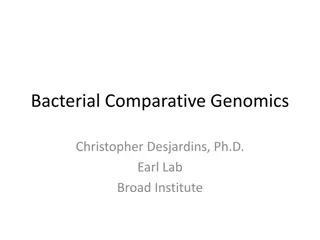Statistical Genomics and Machine Learning Challenges in AI
Explore the intersection of statistical genomics, machine learning, and artificial intelligence through topics like knowledge mining, MMAP algorithm, cloud computing, and historical events such as Garry Kasparov vs IBM Deep Blue. Delve into the concepts of statistical learning methods, data prediction, and genomic analysis to understand how these fields intersect and evolve.
Download Presentation

Please find below an Image/Link to download the presentation.
The content on the website is provided AS IS for your information and personal use only. It may not be sold, licensed, or shared on other websites without obtaining consent from the author.If you encounter any issues during the download, it is possible that the publisher has removed the file from their server.
You are allowed to download the files provided on this website for personal or commercial use, subject to the condition that they are used lawfully. All files are the property of their respective owners.
The content on the website is provided AS IS for your information and personal use only. It may not be sold, licensed, or shared on other websites without obtaining consent from the author.
E N D
Presentation Transcript
Statistical Genomics Statistical Genomics Machine Machine Learning Learning Zhiwu Zhang Washington State University
Administration Final HW due on Friday (April 28) at 3:10PM Final exam: May 3, 4:30-6:30pm, open book, 50 questions Grade submission: May 4 to students and May 5 to university Course evaluation target: 100% responses by Friday (April 28) Group pictures: Wednesday (April 26)
Outline Challenges in finding the best method. Machine learning Knowledge mining MMAP algorithm Cloud computing MMAP performances
Hard coded multiple players' moves won the champion 1996: Garry Kasparov vs IBM deep blue
IFIFIF IF
Machine learning Machine learning is a type of artificial intelligence (AI) that provides computers with the ability to learn without being explicitly programmed. https://engineering.jhu.edu/ams/research/statistics-and-machine-learning
DEEP BLUE (Sum only, no ability to learn) "Machine learning is a computer system that gets better over new data without reprogramming" -Zhiwu Zhang
Statistical learning methods with ML features Linear Regression Cluster Analysis Decision Tree
Knowledge Mining Data Prediction Knowledge
Genomic Prediction LD Sample size Marker density Prediction accuracy h2 PCA Input data decade Impute missing accuracy K-Mean Cluster Analysis Mining the best method: Find the nearest neighbor from the cluster analysis based on existing features, including heritability, and newly gained prediction accuracies. Choose the method that gave the highest prediction accuracy for the nearest neighbor as the candidate to examine in next iteration. No Yes Examined? Output
Knowledge and expansion Next Data Start.Weight FN.Age FN.PctWtLoss FN.postWeight FN.preWeight Weight.Growth Intercept Weight.Growth Slope HTLC BA BD BLC CWAC CWAL DBH HT rootnum rootnumbin gall rustbin c5c6 density lateWood.4 lignin stiffnessTree rrBLUP 0.41 0.57 0.25 0.40 0.39 0.37 0.31 0.43 0.49 0.25 0.47 0.45 0.36 0.43 0.36 0.23 0.26 0.23 0.27 0.26 0.20 0.23 0.16 0.37 gBLUP 0.41 0.58 0.25 0.40 0.39 0.37 0.32 0.43 0.49 0.25 0.47 0.44 0.35 0.42 0.35 0.23 0.26 0.22 0.27 0.25 0.21 0.24 0.17 0.38 cBLUP 0.50 0.74 0.28 0.49 0.49 0.48 0.34 0.39 0.47 0.24 0.44 0.43 0.34 0.39 0.34 0.21 0.26 0.22 0.28 0.23 0.18 0.24 0.16 0.37 Imputed Imputed Highest Highest New Nearest
New data Impute missing accuracy Cluster analysis Let M be the best method for the old data that is the closest to the new data If M is applied for the new data? No Apply M to the new data Yes Stop: output the best
mMAP stays on the top Maize Mice Pine Number of genes
mMap mMap: : An Online Computing Platform to Transform Genotypes to An Online Computing Platform to Transform Genotypes to Phenotypes by Mining the Maximum Accuracy of Prediction Phenotypes by Mining the Maximum Accuracy of Prediction You Tang mMAP website: http://zzlab.net/mMAP
Simulation with GAPIT source("http://zzlab.net/GAPIT/gapit_functions.txt") myGD=read.table(file="http://zzlab.net/GAPIT/data/mdp_numeric.txt",head=T) myGM=read.table(file="http://zzlab.net/GAPIT/data/mdp_SNP_information.txt",head=T) set.seed(99164) n=nrow(myGD) testing=sample(n,round(n/5),replace=F) training=-testing set.seed(99164) mySim=GAPIT.Phenotype.Simulation(GD=myGD, GM=myGM, h2=.7, NQTN=20, QTNDist="normal")
#MMAP names(mySim$Y)=c("Taxa", "SimTrait") write.table(mySim$Y[training,], file="mdp_YRef.txt", sep="\t",quote=F,row.names=F) #upload mdp_numeric.txt and mdp_YRef.txt to MMAP http://zzlab.net/mMAP #Analysis mymMapRef=read.csv("public820.csv") accuracy <- cor(mySim$u[testing], mymMapRef[testing,2] )^2 plot(mymMapRef[testing,2] ,mySim$u[testing]) mtext(paste("R square=", accuracy,sep=""), side = 3)
Outline Challenges in finding the best method. Machine learning Knowledge mining MMAP algorithm Cloud computing MMAP performances























